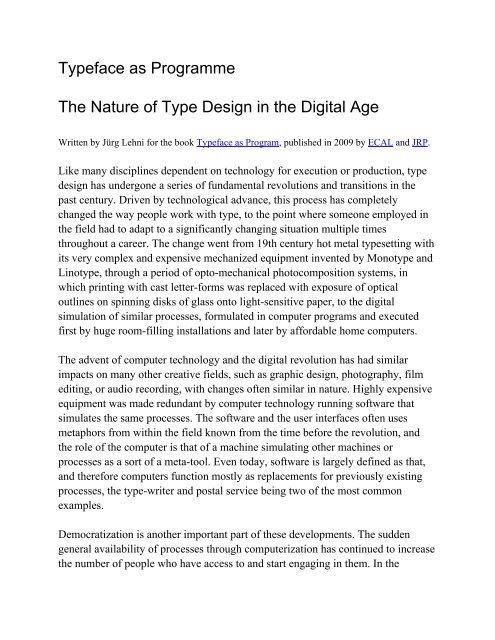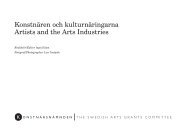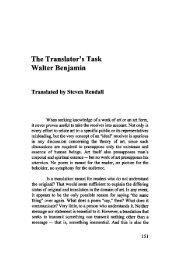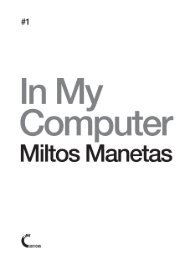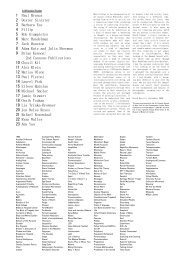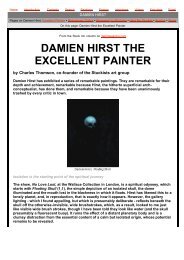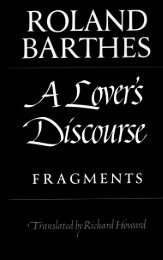Jürg Lehni – Typeface As Progamme - Harald Peter Ström
Jürg Lehni – Typeface As Progamme - Harald Peter Ström
Jürg Lehni – Typeface As Progamme - Harald Peter Ström
Create successful ePaper yourself
Turn your PDF publications into a flip-book with our unique Google optimized e-Paper software.
<strong>Typeface</strong> as Programme<br />
The Nature of Type Design in the Digital Age<br />
Written by <strong>Jürg</strong> <strong>Lehni</strong> for the book <strong>Typeface</strong> as Program, published in 2009 by ECAL and JRP.<br />
Like many disciplines dependent on technology for execution or production, type<br />
design has undergone a series of fundamental revolutions and transitions in the<br />
past century. Driven by technological advance, this process has completely<br />
changed the way people work with type, to the point where someone employed in<br />
the field had to adapt to a significantly changing situation multiple times<br />
throughout a career. The change went from 19th century hot metal typesetting with<br />
its very complex and expensive mechanized equipment invented by Monotype and<br />
Linotype, through a period of opto-mechanical photocomposition systems, in<br />
which printing with cast letter-forms was replaced with exposure of optical<br />
outlines on spinning disks of glass onto light-sensitive paper, to the digital<br />
simulation of similar processes, formulated in computer programs and executed<br />
first by huge room-filling installations and later by affordable home computers.<br />
The advent of computer technology and the digital revolution has had similar<br />
impacts on many other creative fields, such as graphic design, photography, film<br />
editing, or audio recording, with changes often similar in nature. Highly expensive<br />
equipment was made redundant by computer technology running software that<br />
simulates the same processes. The software and the user interfaces often uses<br />
metaphors from within the field known from the time before the revolution, and<br />
the role of the computer is that of a machine simulating other machines or<br />
processes as a sort of a meta-tool. Even today, software is largely defined as that,<br />
and therefore computers function mostly as replacements for previously existing<br />
processes, the type-writer and postal service being two of the most common<br />
examples.<br />
Democratization is another important part of these developments. The sudden<br />
general availability of processes through computerization has continued to increase<br />
the number of people who have access to and start engaging in them. In the
creative sector, this also led to a change in the nature of the work being done, often<br />
to the disapproval of the previous specialists in the field. While type design in the<br />
19th century was a craft accessible to very few selected typographers who together<br />
with punch cutters worked on designs for one of the companies producing<br />
typesetting equipment, it is now a discipline that anyone who has access to a<br />
computer and a license for a type design software can engage in.<br />
These are generally known aspects of this revolution that have been looked at<br />
closely many times before. But the role of software is rarely analyzed beyond this<br />
point. It appears that the general function of the computer is still accepted simply<br />
as a simulation machine, and the question what software could or should provide in<br />
any given field is rarely raised. Instead, the status quo is often accepted as a given,<br />
a language we use in our daily work and that we have stopped questioning, since it<br />
is so ubiquitous that is it almost invisible.<br />
Furthermore, in the historic discourse of digital typefaces, questions regarding the<br />
definition and nature of digital typefaces are hardly risen and the status quo is<br />
rarely questioned beyond the boundaries of the industrial standards.<br />
Fonts, Tools and Software<br />
Traditionally, a font was a complete set of metal characters of a particular typeface<br />
in a given size and style. Etymologically, the word goes back to the French word<br />
fonte and the verb fondre, meaning to melt or to cast, referencing the way fonts<br />
were produced by type foundries. Fonts were one of the ingredients needed in the<br />
printing process in order to be able to print text, and they were bought in full sets<br />
from the foundries. A set included more copies of some letters than others,<br />
depending on the statistical occurrence of each letter in any given language. The<br />
structure of the letter cases that hold the letters represented this distribution.<br />
A font was not a full, independent tool in itself, but rather a part of a tool based<br />
process, which, without it could not take place. Given its physical nature at that<br />
time, it is imaginable that fonts were perceived as tools in themselves. At the same
time they could also be seen as an artwork designed by a typographer and executed<br />
by a punch cutter.<br />
Today, digital fonts are legally defined as software, once again as the digital<br />
counterpart of a tool. This has broad consequences for the way fonts are distributed<br />
and sold, and the way type designers are earning their money, since licensing<br />
schemes similar to the ones found in software applications are in place: The End<br />
User License Agreements (EULA) entitle the end users of fonts to install them on a<br />
defined number of computers within the same household or office. The degree of<br />
usage of the font in this case has no impact on the price. <strong>As</strong> soon as the user has<br />
bought the license, he owns the right of usage within the defined boundaries and<br />
therefore can use the font as a tool as much as he likes, as long as he does not<br />
infringe the rules of the agreement. This leads for example to the absurd situation<br />
where a big TV company in certain circumstances may pay the same amount of<br />
money for a font that is aired daily for years on millions of TV screens as a small<br />
graphic design office that uses the font once for a client’s job. Both buy the basic<br />
right to use the font as a tool for whatever they need it for, and the creative work in<br />
the typeface is unaccounted for.<br />
While there are foundries that have created complicated agreements for such<br />
special cases, the basic problem of unequal usage remains and is criticised by<br />
many type designers: the fact that the creative work is not taken into account in the<br />
definition as a tool, ignoring the fact that a typeface is also an artistic work by a<br />
creative individual.<br />
An alternative way of defining typefaces is as library or a family of graphical<br />
shapes along with rules that describe how to assign these to letters, and how to<br />
adjust the space between them. If this definition was used legally, another system<br />
would suggest itself: one based on royalties, as in the music industry or applied<br />
photography, both fields where an artwork or a composition is licensed for specific<br />
media based distribution. The licensing costs then mostly depend on the duration<br />
of the segment, the size of the image, visibility, distribution, etc. Specific<br />
associations claim these royalties and distribute them among their members,<br />
enforcing copyright law and ensuring rights of authorship for the protected works.
Such authorship based systems are not necessarily a viable way for typefaces, as<br />
they have their own share of problems in the digital age, namely software piracy.<br />
Digital Rights Management (DRM) as a possible solutions proposed by big<br />
corporations is in the process of failing and is mostly being abandoned at the<br />
moment of writing, since the consumers are not willing to follow to the rules they<br />
force upon them. Nevertheless it remains curious that this legal definition as<br />
software has been chosen, especially since there is little evidence that digital<br />
typefaces actually really work as software.<br />
While it is true that the technologies used today for the digital definition of<br />
typefaces such as PostScript hold qualities of software and programming<br />
languages, there is little evidence that the file formats that describe typefaces such<br />
as Type 1 and OpenType actually take advantage of this flexibility. PostScript is a<br />
page description language developed by Adobe Systems Inc. In order to offer the<br />
greatest flexibility and future scalability, it was designed as a full programming<br />
language. Type 1 are the type-specific aspects of this language, and just like the<br />
rest of PostScript, typefaces in PostScript are formulated as sequences of program<br />
code. But since these codes describe graphical shapes and lists of sizes and spacing<br />
between characters, there is little reason that it really should be considered<br />
software. The recent introduction of a new open font format named Unified Font<br />
Object (UFO) that is entirely based on XML descriptions proves that all this<br />
information can be stored without being written as software, since XML is a<br />
descriptive markup language like HTML, not a programming language. TrueType<br />
is omitted in this comparison as basically the same applies to that format, and both<br />
Type 1 and TrueType formats are now merged in the more recent OpenType<br />
standard.<br />
Another line of reasoning is that if typefaces were full software, they would not<br />
have to rely on a computer operating system (OS) and its underlying typesetting<br />
mechanisms. Just like the metal fonts that were an ingredient for a typesettingmachine,<br />
the digital fonts are data for a host software that knows how to read it and<br />
lay it out.<br />
So if typefaces are legally defined as software, but are not currently behaving like<br />
software, this raises questions: Does the current definition of digital typefaces hold
unused potential? Could or should digital type design incorporate the possibilities<br />
of software more?<br />
Approaches to <strong>Typeface</strong>s as Software<br />
The process of digitalization and computerization of type-oriented technology is<br />
probably a never ending one since new innovative approaches are continuously<br />
being found for how to draw and produce type designs, but the most fundamental<br />
changes and revolutions in the field have happened, and the process of software<br />
standardization is largely completed. At the beginning of this process, there was<br />
the question of how typesetting is best represented in software and executed or<br />
output by printing devices. With the introduction of pixel based display technology<br />
such as CRT monitors, there was also the problem of how to represent glyph<br />
outlines appropriately on such low resolution devices and not loose the font’s main<br />
characteristics. There were many different proposals, and through a slow process<br />
of selection and advancement, some of them were abandoned while others merged<br />
and became standards.<br />
This exciting time of technical innovation has lead to many different efforts and<br />
resulting systems, but now at the end of this process of standardization, there is<br />
primarily one system the whole industry is focused on: the previously mentioned<br />
OpenType, a standard coined by Microsoft together with Adobe Systems as a<br />
result of the “Type War” between Apple’s TrueType standard and Adobe System’s<br />
PostScript. Microsoft, who previously licensed the TrueType technology from<br />
Apple, decided to move ahead and create their own standard based on TrueType in<br />
the early 1990s, after negotiations with Apple to license their advanced typography<br />
technology called “GX Typography” failed. Adobe Systems joined in 1996 and<br />
added support for the glyph outline descriptions based on its PostScript’s Type 1<br />
fonts. In 2005, OpenType started migrating to an open standard under the<br />
International Organization for Standardization (ISO) and the process was<br />
completed in 2007 when it was accepted as a free, publicly available standard.<br />
This system has become the standard for type on most of today’s modern operating<br />
systems such as Mac OS X, Windows and Linux, and most typesetting applications
support its extended features. But there is a rather large niche in which one of the<br />
other proposals from the period of early digital type technology has survived until<br />
today: The typesetting system TeX with its spin-off project LaTeX, a collection of<br />
macros to simplify TeX, and its font system Metafont, used mostly in academia,<br />
especially in the mathematics, computer science, and physics communities. Both<br />
TeX and Metafont were conceived and designed by highly acclaimed computer<br />
scientist Donald E. Knuth as a solution to the problems of typesetting complex<br />
mathematical formulas and more generally scientific publications. TeX has been<br />
noted as one of the most sophisticated digital typographical systems in the world.<br />
TeX (and therefore LaTeX) have adapted to the same wider spread font standards<br />
mentioned above. Nevertheless Metafont is still relevant, as it is largely unknown<br />
in the domain of type design and has a history that is still of interest for more<br />
recent experiments in programmatic type design based on the principles of<br />
parametric variations.<br />
TeX and Metafont as an Example of Early<br />
Parametrised Digital Typesetting<br />
<strong>As</strong> the author of the highly acclaimed monograph The Art of Computer<br />
Programming, listed by the American Scientist as one of the 12 best physicalscience<br />
monographs of the 20th century, Donald E. Knuth was always concerned<br />
with the printed appearance of his works and fascinated by the technical facilities<br />
and the skills of their operators. The quality of the first three published volumes of<br />
his monograph, all typeset in Monotype Modern 8A on mechanical hot type<br />
machines from the same company provided great satisfaction.<br />
When in 1977 due to financial restrictions the new edition of volume 2 was to be<br />
reproduced with a new optical typesetting system rather than the already<br />
disappearing Monotype machines, he saw his world collapse. The optical<br />
typesetting systems mostly used typefaces of minor quality, copied or derived from<br />
the ones carefully designed by typographers for Monotype and other hot type<br />
foundries. For Knuth the beautifully typeset texts and mathematical equations were<br />
not simply a feature nice to have, they were part of his motivation to actually write<br />
these books. Knuth was obsessed with the beauty of his printed works. In the
introduction to Computer Modern <strong>Typeface</strong>s, the book about a family of<br />
parametrizable fonts that he developed using his Metafont system, he says he has<br />
“ink running through his veins.” If his works were going to be badly type set, he<br />
decided there was no point in continuing to write them since the finished products<br />
were just too painful to look at. He realized he would have to do something about<br />
it.<br />
Excited by the impending technological revolution in print that would bring digital<br />
printing at a high enough resolution that the pixels would not be visible to the<br />
human eye, he decided to come up with a new system that would correctly<br />
compose typography in pixels, independent from machines and their resolution.<br />
The little squares that either contain 1 or 0, to represent ink or no ink, he<br />
concluded, were part of his realm as a computer scientist, so he assumed he should<br />
be able to come up with a better solution rather quickly. Knuth reasoned that if<br />
solved properly, this work could be of use for a very long time, since this basic<br />
principle of pixels as the core component of digital printing would not change, no<br />
matter how much the technology surrounding it does.<br />
All this happened before Adobe Systems was founded and the base for the page<br />
description language PostScript was laid out. At the beginning of this endeavour,<br />
Knuth did not even have the possibility to see the results on screen. Each time he<br />
wanted to try out a change in the software he had to make digital prints on a<br />
facility without easy or regular access.These huge devices were very expensive to<br />
run and an acquisition only made sense for large corporations with continuous use.<br />
In 1978 Knuth was invited to speak in the prestigious Josiah Willard Gibbs<br />
Lecture, established by the American Mathematical Society (AMS) in 1923 and<br />
held annually to to increase public awareness of the aspects of mathematics and its<br />
applications (http://en.wikipedia.org/wiki/Mathematics). Knuth quite bravely<br />
decided that instead of speaking purely about mathematics or algorithms, his talk<br />
should be about this new project that at the time received all his focus, preventing<br />
him from advancing with other projects. In the lecture entitled “Mathematical<br />
Typography,” Knuth presented his first analysis of the problems of recent printing<br />
technology in the domain of mathematical publications to a large group of<br />
mathematicians and scientists. Studying and comparing many different examples<br />
from the “Transactions of the American Mathematical Society,” a publication that
egan in 1900 and has more than 230 volumes to date, Knuth found that they were<br />
printed in at least 12 different styles. Of these the quality appeared to have<br />
generally declined to an absolute low in recent years, at which time he decided<br />
there was no point in continuing to write for these publications anymore.<br />
Knuth then proposed solutions involving a row of computer-assisted methods of<br />
composition and layout that form the core of TeX, as well as basic principles for<br />
mathematical type design. In order to explain that territory, he first focused on past<br />
proposals of typography based on mathematical and geometric constructions, such<br />
as the mostly geometry-based works by Felice Feliciano, Luca Pacioli, Francesco<br />
Torniello and Giovani Battista Palatino in Italy, as well as Geofroy Tory and later<br />
the commission of a group of artists and typographers to create a royal alphabet for<br />
Louis XIV in France, before dwelling on his proposal for a remedy that finally<br />
included some mathematical formulas to describe the characteristics of the curves<br />
he was looking for. He ended the talk by presenting a row of tests made with a<br />
rough, early version of Metafont, all playful and experimental in nature.<br />
It is interesting to note that the term Mathematical Typography for him really goes<br />
both ways in a symbiotic, symmetrical way: there are the new typographic tools, to<br />
be created to help mathematical formulas to be correctly and appropriately typeset,<br />
and the mathematical formulas needed to solve the typographic problems that the<br />
tools required to be designed stood in a mutual relation.<br />
To his surprise, the somewhat unconventional lecture seemed to strike a cord with<br />
many of the attendees, and soon after he received various proposals for<br />
mathematical solutions to the outlined problems: the perfect mathematical<br />
formulation of curves that offer all the flexibility and freedom to describe and<br />
modulate the strokes of fonts in an abstract and flexible way.<br />
In his speech he formulated the basic idea of imaginary pen strokes that follow lists<br />
of co-ordinates, all parametrised, to describe the glyphs of the typeface. He<br />
assumed that such a system, formulated as a specific programming language,<br />
would offer all the required flexibility. According to Knuth there was an interesting<br />
and very pragmatic reason that led to this pen-based approach over the outline<br />
based strategy that Adobe Systems and others have chosen later: in his early<br />
experiments, Knuth tried to scan existing mechanical font glyphs in order to
compose their outlines digitally. But since the available equipment at the time was<br />
a video camera that distorted the image and was very sensitive to light changes, the<br />
results were far from satisfactory and Knuth decided that it would make more<br />
sense to produce a system that would allow the formulation of the logic of the<br />
glyphs of a font in the way that they were initially drawn and produced by their<br />
designers, rather than simply describing their final appearance for production by a<br />
printing device. The solution therefore had to be based on calligraphic principles of<br />
pen strokes with different nibs and the possibility to extend the resulting geometry<br />
with additions, such as serifs. If a font was formulated in its own inherent logic, he<br />
concluded, it would be much easier to adapt it for printing in various sizes,<br />
changing its contrast, glyph width, x-height, etc. These requirements were directly<br />
inspired by the observation that metal letters were produced for specific sizes with<br />
different features depending on the size. By making these variations automatic the<br />
highest quality possible would be achieved at any size while at the same time<br />
respecting typographic tradition.<br />
At the beginning of this digressive side-project he thought would only take six<br />
months to complete, Knuth had little knowledge of typography and type design<br />
beyond the appreciation of his printed works and a fascination for the trade. But<br />
soon it became apparent that the project was going to be far more complex. The<br />
process of finalizing the first versions of both Metafont and TeX in the end took<br />
four years until the reprint of volume 2 could finally be produced in 1981.<br />
After seeing the results, Knuth was highly disappointed. The volume was printed<br />
with a newer facility at a higher resolution than the one he had available for doing<br />
his tests, which brought out details he had not been able to see before. While the<br />
quality was still better than what the optical system would have produced at that<br />
time, they did not match the quality of the mechanically printed earlier volumes,<br />
and he was therefore not yet satisfied with the results. Instead of giving up, he went<br />
on to improve the situation, and the project grew to what in retrospect made him<br />
“put the rest of his life on hold” for eight to 10 years. This strongly affected the<br />
work on the missing four of the seven planned volumes of the monograph.<br />
Immediately after the reprint of volume 2, the phase of refinement started, for<br />
which Knuth sought support from professional typographers, including Hermann<br />
Zapf, whom he first met in 1980, as well as Charles Bigelow, Matthew Carter, Kris
Holmes and Richard Southall. Based on the input of these professionals, Knuth<br />
went on redesigning and improving large parts of both Metafont and his Computer<br />
Modern typefaces. During this time, Knuth and Zapf were also commissioned by<br />
the American Mathematical Society (AMS) to work on a new typeface for<br />
mathematics, called AMS Euler. They were joined in their efforts at refinement by<br />
the PhD student John D. Hobby, who worked on improving the curve algorithms<br />
based on many observations made with the first version. In the years that followed,<br />
TeX and Metafont started to be adapted by larger groups of users mostly in the<br />
academic world. Workshops were held, and the adaption of the system beyond the<br />
scope of roman typefaces was tested, which led to further improvements. It was<br />
Knuth’s aim to provide a system that could be finalised once and for all and would<br />
never have to change again once the work was finished, a system that 30 years<br />
later still would produce the same results in print, with varying quality depending<br />
on the equipment used. In 1984, Knuth finally published the revised system<br />
Metafont84 and started to be satisfied with the results. In 1987, the AMS started to<br />
encourage authors to submit their papers for the “Transactions of the American<br />
Mathematical Society” in TeX form. This was the very journal that Knuth had<br />
analyzed in his speech almost 10 years earlier, the journal for which he threatened<br />
to stop publishing articles if the quality was going to degrade beyond a point of<br />
acceptable quality.<br />
Now, at the age of 71, Knuth is still in the process of finishing Volume 4 of The<br />
Art of Computer Programming, a work highly anticipated for decades. Volume 5 is<br />
currently planed to be released in 2015. He may never be able to finish volumes 6<br />
and 7.<br />
Knuth likes to think that of the 10 years spent on TeX and Metafont, 6 - 7 would be<br />
regained by being far more efficient with publishing, and maybe more importantly<br />
by again enjoying doing so. There are other reasons for the delay of his Volume 4<br />
than simply this digression. But it is hard to completely rule it out as one of the<br />
factors for the delay of his highly respected work on computer science. It is an<br />
interesting thought that his obsession with the beauty of printed matter might play<br />
a role in the fact that he may never be able to publish the full extent of his<br />
knowledge.
<strong>As</strong> a final observation, maybe the stated technical reason of the lack of suitable<br />
equipment was partly an excuse for Knuth to indulge in this far more interesting<br />
and rewarding task than the simple description of clearly defined outlines, a project<br />
that was also closer to his heart as a passionate computer scientist: the use of<br />
computer technology and mathematics to formulate a flexible language suitable to<br />
describe letter-forms in an abstract, flexible way. It is this decision that makes<br />
Metafont such an interesting proposal that even today, 30 years later, it is as<br />
relevant as then, when it was one of the first projects for digitized type. Many of<br />
the more recent experiments with scripted typefaces, such as Calligrapher by<br />
François Rappo and myself Type Generator by Remo Caminada and Ludovic<br />
Varone or Kalliculator by Frederik Berlaen share quite a lot of its mindset and<br />
could learn a lot from Knuth’s endeavors, were they more accessible to people<br />
from the field of digital typography.<br />
While most of the questions raised about the nature of digital typefaces as software<br />
remain open, ideally they will contribute to a clearer understanding of the different<br />
possibilities and ways forward. It seems that we are just at the beginning of a<br />
general exploration into the field of self made tools to produce new results, very<br />
much along the lines of Knuth’s thinking. He was willing to sacrifice a respectable<br />
amount of his scientific career to this cause. In the following interviews, such<br />
questions of licensing, authorship, design, creativity and the role of software and<br />
tools are further expanded upon.<br />
Additional reading<br />
Robin Kinross, Modern typography, Hyphen Press, London, 2004, p. 158-182,<br />
Chapter 13 “Modernity after modernism”, sub-chapter “Letters as bits, The<br />
moment of PostScript, Font wars, Legibility wars, reform and research”,<br />
Fred Smeijers, Type Now, Hyphen Press, London, 2003. p. 60-66, Glossary<br />
Fred Smeijers, Counterpunch, Hyphen Press, London, 1996
Robert Southall, Printer’s Type in the twentieth century, British Library, London,<br />
2005<br />
Donald E. Knuth, Digital Typography, Center for the Study of Language and<br />
Information, Stanford, California, 1999<br />
Donald E. Knuth, Computers & Typesetting Volume E, Computer Modern<br />
<strong>Typeface</strong>s, Addison-Wesley, Reading, Massachusetts, 1986


